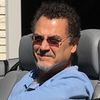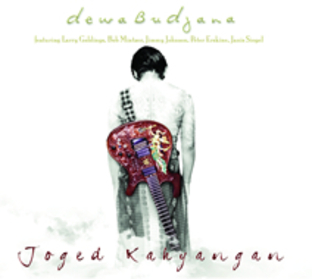The route from pop music star to jazz master has been a long developing trend in the music of guitarist Dewa Budjana. As the lead guitarist and songwriter for the pop/rock group Gigi for the last 20 years, a wildly popular band in Indonesia, Budjana's music has been heard by millions of adoring fans. But Budjana's music is the distillation of many diverse influences outside of the world of rock and pop, including the fusion music of Mahavishnu Orchestra and Soft Machine, and the Indonesian music rooted in his heritage.
On Joged Kahyangan (which translates into "Dancing Heaven") Dewa is joined with a talented group of American, West Coast based musicians including the saxophonist Bob Mintzer, the bassist Jimmy Johnson, the keyboard artist Larry Goldings and the drummer Peter Erskine. Together they play eight compositions, all original music by Budjana. It was the guitarist's initial email contact with drummer Erskine back in 2002 that led to a recording titled Samsara and a continued relationship. Erskine, the one time Weather Report drummer, saw in Budjana a unique and creative sound that could be further developed and explored.
Mr. Budjana's music has matured, as evidenced by some of the sophisticated themes he has written for this album. From the opening title "Foggy Cloud," written while in the East Javanese Mountains, you get the sense that Mr. Budjana's music is strongly tied to memorable melodies. The ostinato phrasing is used as a structure upon which he builds tension employing various tones and textures on his guitar. On this song Budjana's sound ranges from the smoothly slurred, studio precise lines of a Larry Carlton, to the power-driven lines of early Mahavishnu, to the expansive atmospheric lines of early Pat Metheny. The band superbly drives the rhythmic energy with taut precision and inventive soloing, especially by keyboardist Larry Goldings, whose is a fountainhead of taste and subtlety.
The title song "Joged Kahyangan" is an uplifting aural dance using a fascinating mixture of eastern and western musical styles. Bassist Jimmy Johnson's spritely solo on electric bass is a miniature delight. Bob Mintzer on bass clarinet and Budjana on acoustic guitar trade elegant dance steps in magical time, as Goldings' synthesizer work conjures up a mystical backdrop. This one flows so smoothly that it requires multiple listening to appreciate all the nuances.
"Dang Hyang Story," inspired by Budjana's Hindu faith, is the most purely fusion sounding composition using an exotic Middle Eastern head that breaks into a more melodic core. The complex serpentine lines are done in precise unison by Mintzer on tenor, Budjana on searing electric guitar and Goldings on synthesizer. It features some rhythmically complex drum work by the impressive Peter Erskine, who seems at ease with the eastern influence imbedded in Dewa's music. When he solos, Dewa's guitar takes on a heavy fusion tone, a ripping sound that is reminiscent of early Allan Holdsworth. The composition is a powerful yet strangely hopeful song, a marvelous mix of both energy and beauty.
The ballad "As You Leave My Nest" is a bit too soppy for me. Vocalist Janis Siegel lends her considerable talents and lyrics to this pop oriented ballad with some soaring vocals.
"Majik Blue" again uses a series of repeated, descending lines as the basis for the composition. Mintzer takes up soprano saxophone and Goldings trades his piano and keyboard for what sounds like a B3 organ for part of the song. Budjana sets his guitar into piercing mode and Johnson plays a brief but potent solo in a song that sounds like a tip of the hat to Weather Report. The complex repeating lines are expertly matched by the entire band in a show of precision and solidarity.
"Erskoman," a composition dedicated to the drummer Peter Erskine, is a groove based song that has all its participants in exquisite form. Budjana's guitar is perhaps most musical here with a pleasant, single line tone that he occasionally juxtaposes at the breaks into powerful chording and octave work. Goldings is a delight on his B3 organ, the perfect instrument on this swinging groove. Erskine lets loose with a series of syncopated breaks that demonstrate his formidable rhythmic prowess. Budjana returns with his synthesized sounding guitar pulsing out inventive lines that defy categorization or predictability. The music was mostly recorded in one or two takes. As this track ends, the running microphone catches the band acknowledging what any listener can easily surmise, this was a good take.
"Guru Mandala" is perhaps the funkiest of the songs on the album, with Erskine's driving back beat prominent. Budjana plays some expressive lines on what sounds like an acoustic guitar, but for the most part the song sticks to a simple repeating melodic line that fades into an eastern chant-like coda.
"Bora's Ballad" is an instrumental version of the previous song "As You Leave My Nest" with Erskine's barely perceptible brush work and Golding's hushed organ work. The song offers a peaceful conclusion to an otherwise stirring album. Budjana has a delicate side to his playing, a side that is both pretty and sensitive, but that can at times border on overtly sentimental as it does here.
Dewa Budjana has impressive skills both as a player and as a composer. On Joged Kahyangan he manages to skillfully mix the musical influences of his native Indonesia with pop, jazz, fusion and rock into an impressive amalgam that is unique to him and worth watching as it continues to develop.

